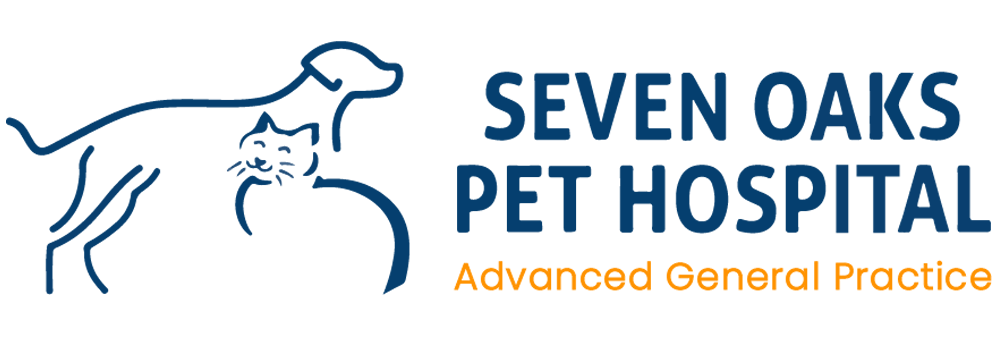Anterior Cruciate Ligament (ACL) Rupture Surgery
To download and print this information, please click here.
Modified Retinacular Imbrication Technique (MRIT) / Lateral Suture Technique
- The cranial cruciate ligament (C) is one of the main stabilizing structures of the stifle joint (in man this joint would be called the knee). The cranial cruciate ligament serves to prevent forward movement/Slipping of the tibia bone (shin bone) relative to the femur bone (thigh bone), to prevent internal rotation of the tibia bone, and to limit hyperextension of the stifle. Its main job is to hold the femur and tibia in proper alignment during all forms of activity.
- Two meniscus cartilages (M) located inside of the joint are crescent-shaped pads that serve as cushions, provide stability to the joint, and help to push the nourishing joint fluid into the cartilage of the femur and tibia bones.
Anterior Cruciate ligament Disease.
- Anterior cruciate ligament disease is the most common orthopedic condition in dogs and inevitably results in degenerative joint disease (arthritis) in the knee joint. It is typically the result of a degenerative process in the knee joint of dogs, rather than from athletic injury or trauma. Traumatic ACL rupture may be seen in less than5-10% of the total ACL ruptures seen in dogs.
- It may affect all breeds and all sizes of dogs but most common in large breeds.
- The ligament may undergo progressive degeneration and partial tearing over a period of months before it suddenly ruptures during normal physical activity and show the symptoms of ACL rupture.
- The cause is unknown, but the conformation of the limbs and genetics may play a role.
- Partial ligament tears may be difficult to diagnose and frequently occur in both legs at the same time.
- When the ligament tears, the stifle becomes unstable. The femur and tibia bones form the joint then rub back and forth on each other (termed “drawer movement”). This results in pain due to stretching of the joint capsule, potential damage to the meniscus cartilage, and inflammation of the joint (called arthritis). In about half of the patients, the meniscus cartilage on the inner side of the joint (medial meniscus) has been torn and the damaged portion must be removed.
Symptoms of ACL disease
- Limping
- Holding the hind limb up
- Sitting with the leg stuck out to the side
- Stiffness, especially after exercise
- Pain when the joint is moved or touched
- Swelling of the joint
- Sometimes clicking sound when walking
How is ACL disease diagnosed?
- Dog’s medical history and a complete examination using tests of the integrity of the ACL, including the “cranial drawer” and “tibial thrust” tests. X-rays should be performed to assess the amount of arthritis present and aid in determining treatment options. Sedation or anesthesia is necessary for making the definitive diagnosis, to avoid causing pain to your pet.
- All dogs that are going to have cruciate surgery should have a correctly positioned x-ray taken to measure the slope of the tibia so that an informed decision can be made on the appropriate type of surgery that should be performed. In our experience dogs that have a steep tibial slope (especially large breeds) do much better with the TPLO surgery. This may not be an important factor in small breeds even with a steep tibial slope, but the clients should be aware of the fact that a steep tibial slope will put much greater force on the synthetic bands we use in surgery (MRIT), therefore they may break.
Surgical Treatment Options we offer:
- Extra-capsular: MRIT/LSS
- Intra-capsular: TPLO (Tibial Plateau Leveling Osteotomy) Or TTA ( Tibial Tuberosity Advancement)
Modified Retinacular Imbrication Technique (MRIT) /Lateral Suture Stabilization (LSS)
- This technique is used most commonly for small dogs and cats.
- It is one of the extra-capsular techniques which means the function of the ACL, which is inside the joint, is replaced by placing a suture outside the joint. The suture most commonly a type of medical-grade “fishing line” is placed around the fabella and through the proximal tibia (Shin bone).
- The lateral imbrications technique has good outcomes in small breed dogs
- Large or Giant breeds of dogs have a better outcome when the TPLO is performed.
- Dogs that have a steeply-sloped tibial plateau should receive the TPLO instead of the lateral imbrications technique. The lateral imbrication technique cannot overcome the forces on the stifle joint caused by a steep slope and frequently the nylon band will tear or loosen in the post-op period.
Expected Recovery period:
- By 2 weeks after the surgery, your pet should be touching the toes to the ground at a walk.
- By 8 weeks the lameness should be mild to moderate.
- By 6 months after the surgery, your pet should be using the limb well.
Prognosis:
- With the extra-capsular techniques, about 85% of the cases are significantly improved from their preoperative state. With the extra-capsular technique, we can expect that 50% of these dogs will have some degree of lameness, whether it is mild or intermittent following heavy activity. On the other hand, about 50% regain normal function of the limb.
- Even though these surgeries may not return the limb to perfectly normal function, these dogs usually are greatly improved over their condition prior to surgery.
The extra-capsular techniques will not stop the progression of arthritis that is already present in the joint. As a result, your pet may have some stiffness of the limb in the mornings. In addition, your pet may have some lameness after heavy exercise or during weather changes. To help with stiffness Chondroitin sulfate, MSM, and glucosamine combinations, Adequan injections and NSAID (Non- Steroidal Analgesic Inflammatory Drug) may be given.



